How Much Does a Kitchen Remodel Cost? [2024 Data]
Normal range: $14,597 - $41,482
The average U.S. homeowner spends $26,945 on a kitchen remodel, but the cost ranges from $14,597 to $41,482, depending on the scope of the project.
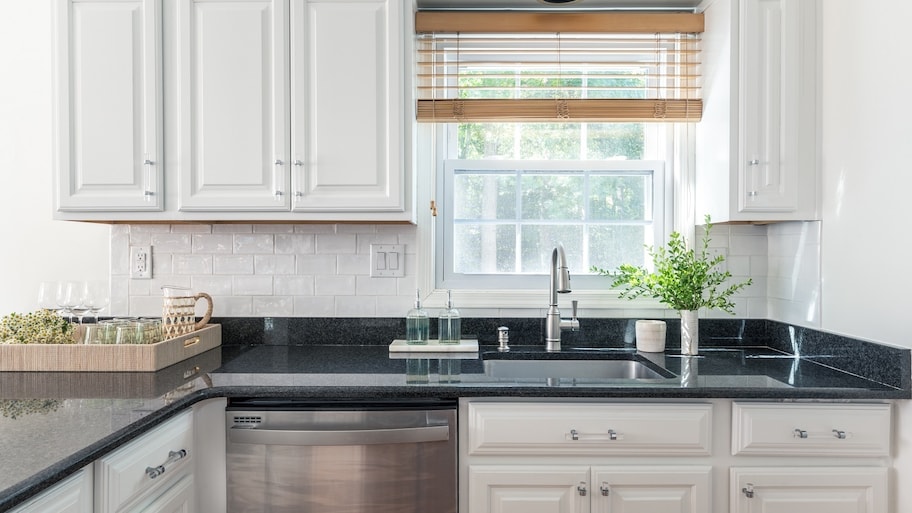

The average kitchen remodel cost is around $26,945, though it ranges greatly, depending on materials, labor, and location. Most homeowners pay between $14,597 and $41,482. With major renovations, such as adding new appliances and upgrading countertops, a kitchen remodel could cost you at least $3,500.
Whether you want to completely overhaul your kitchen or just give it a fresher look, it’s a big undertaking with a substantial price tag. Here's what to know to effectively budget for the new kitchen of your dreams.
- Average
- $26,945
- Low end
- $3,500
- high end
- $65,000
Average Kitchen Remodel Cost by Project Scope
The first step to figuring out how much it costs to build a kitchen is gauging the scale of your remodel. Your current kitchen footprint, the condition of your appliances, counters, and flooring, your needs and desires, and your budget will all impact whether you decide to do a minor, major, or complete remodel. Here’s what to expect at each level.
| Scale of Project | Average Cost |
|---|---|
| Minor | $10,000–$20,000 |
| Major | $20,000–$65,000 |
| Complete | $65,000–$130,000+ |
Minor Kitchen Remodel
You can transform your kitchen without going over budget with a minor kitchen remodel, which may include:
Improving aesthetics and functionality without changing the kitchen layout
Painting walls for a fresh look
Refinishing or refacing cabinets or replacing them with stock cabinets
Keeping appliances or replacing one or two for energy-efficient options
Upgrading flooring or countertops
Installing a new kitchen sink and faucet
Average Cost: $10,000–$20,000
Major Kitchen Remodel
If you're looking for new energy-efficient appliances, high-end flooring and countertop materials, and customization for your cabinets, then a major kitchen remodel may be for you. Things to consider for a major remodel are:
Painting walls
New appliances and garbage disposal
Upgrading flooring and countertops
Semi-custom cabinetry with new hardware
New lighting fixtures
New kitchen sink and faucet with high-end brands and finishes
Average Cost: $20,000–$65,000
Complete Kitchen Remodel
With a complete kitchen renovation, you’re looking at a total overhaul. You’ll be tearing out walls, gutting out just about everything, and moving plumbing and electrical. In other words, you're starting fresh and making way for luxury materials and top-of-the-line appliances. A complete kitchen remodel includes:
Changing the kitchen footprint
Moving plumbing, electrical, and a gas line
Luxury countertop materials like marble
Upgrading to high-end flooring like stone tiles
Custom cabinetry
High-end smart appliances and built-ins
Painting walls
New luxury kitchen sink and faucet with built-in filtration
Lighting additions and under-cabinet lighting
Average Cost: $65,000–$130,000 or more
Kitchen Remodel Cost Breakdown
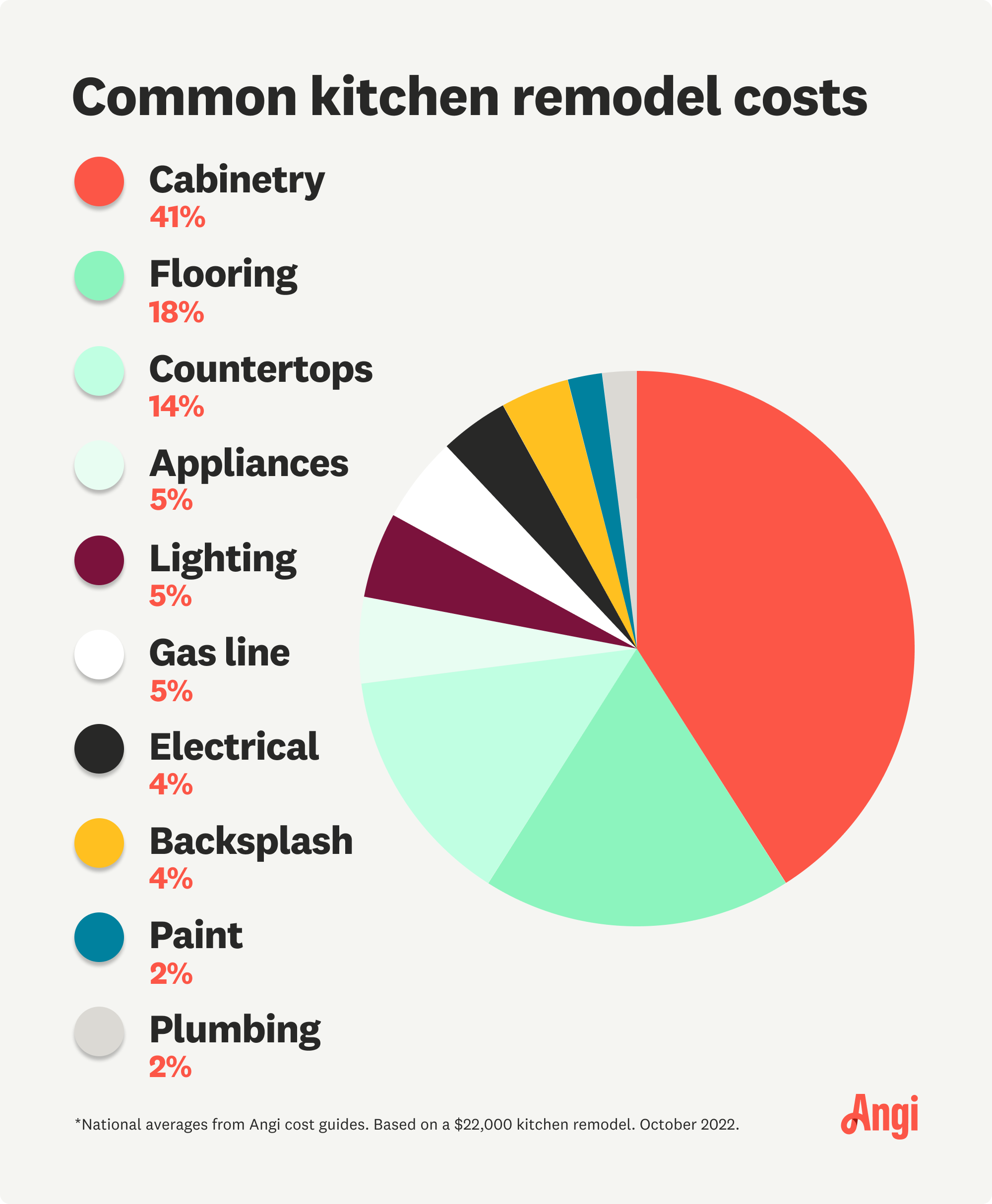
With kitchen remodeling ranging from $3,500 all the way up to $65,000, it can be easier to budget when you know how much to expect for different factors, like appliances, countertops, and flooring. Here’s how much several kitchen remodel components cost on average.
Appliances
Dishwashers, sinks, faucets, refrigerators, microwaves, cooktops, ovens, range hoods, and other appliances are all considerations when building a new kitchen. Prices vary greatly, from less than $100 to $5,000 or more, depending on the item. A budget also needs to factor in the cost of having a kitchen appliance installed, which ranges from $125 to $300.
Cabinets
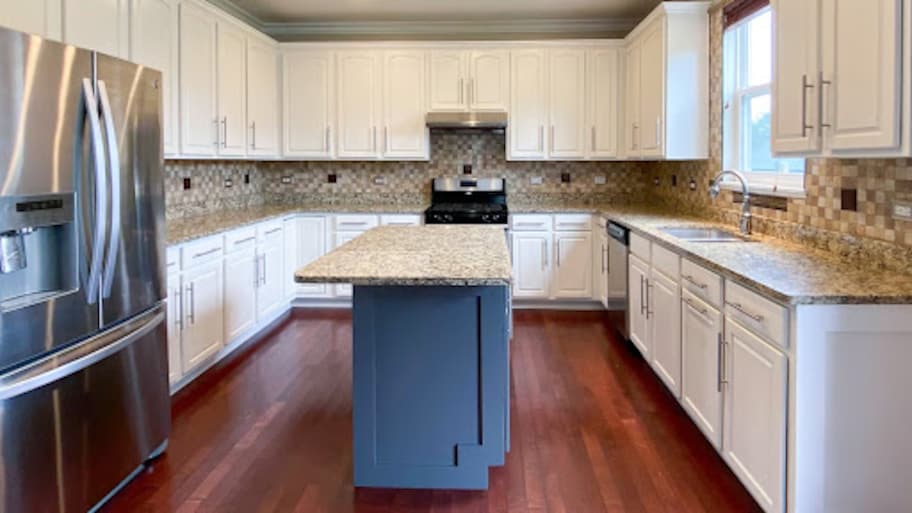
New cabinetry is a major component of any kitchen remodel. The cost of kitchen cabinets ranges from $2,000 to $28,000 or more, depending on the amount of storage you’re adding and the materials you choose. They can take up 40% or more of a kitchen remodel. To put it in perspective, cabinets can cost around $8,400 in a $30,000 remodel.
| Custom Cabinets | Stock Cabinets |
|---|---|
| More expensive option | Budget-friendly |
| $500 to $1,200 per linear foot | $100 to $300 per linear foot |
| Can personalize all aspects | Pre-made with little personalization |
| Can take 6-8 weeks to build | Can ship when ordered |
Cabinet Hardware
Kitchen cabinet hardware costs range from under $100 on the low end to above $10,000 on the high end. For example, rare and ornate handles or knobs can go for $500 each, but it’s also possible to find stylish options for only $1 to $2 apiece.
Countertops
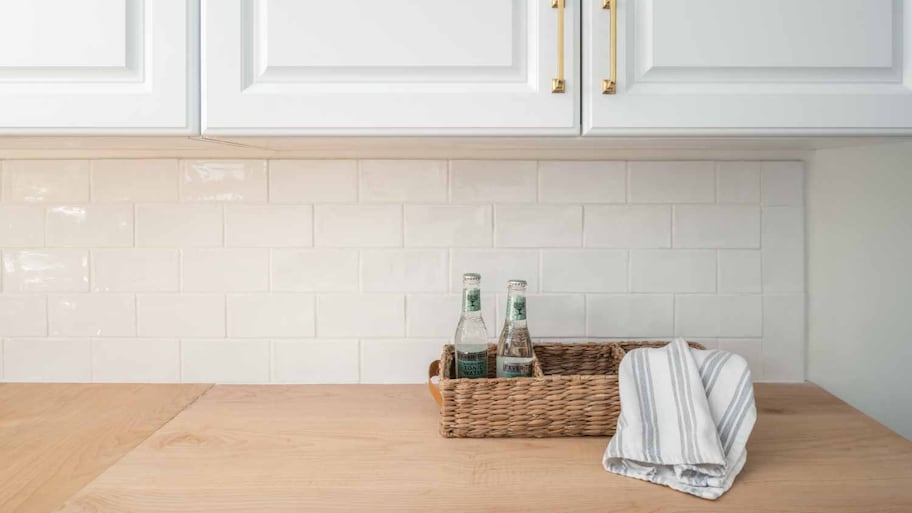
Though the average cost range to install countertops is $1,870 to $4,400, you may pay up to $10,000 or more for the materials and labor required to install certain options, like stainless steel or quartz countertops.
Looking at the wide range of countertop materials and styles can be overwhelming. Laminate and ceramic are the most budget-friendly, while marble is the most costly. The materials listed below vary by quality, durability, availability of colors, installation methods, and required maintenance.
| Countertop Material | Average Cost per Square Foot |
|---|---|
| Granite | $10–$140 |
| Soapstone | $20–$70 |
| Marble | $15–$190 |
| Slate | $30–$90 |
| Limestone | $10–$70 |
| Travertine | $11–$35 |
| Quartz | $15–$70 |
| Corian | $20–$75 |
| Laminate | $8–$35 |
| Ceramic or porcelain | $1–$40 |
| Wood | $18–$38 |
| Stainless steel | $60–$100 |
The cost of installing a new backsplash ranges from $500 to $1,700 or $15 to $40 per square foot. on average for all the materials and labor involved. If you’re a handy DIYer, doing this project yourself can reduce the price by up to half because labor fees make up roughly 40% of the overall cost.
A backsplash is an easier project to DIY compared to other kitchen renovations, like installing cabinets.
Here are a few backsplash materials to consider:
| Backsplash Material | Average Cost per Square Foot |
|---|---|
| Tile | $25 |
| Marble | $10–$95 |
| Tin | $10–$30 |
| Brick | $10–$40 |
| Glass | $30 |
| Stainless steel | $20 |
Flooring
New laminate or tile floors are common for major kitchen remodels. Depending on square footage, the cost to install a new floor is $1,000 to $4,000. Budget kitchen floor ideas include sheet vinyl, vinyl tile, linoleum, and laminate.
| Budget-Friendly Flooring Materials | Average Cost per Square Foot |
|---|---|
| Sheet vinyl | $3 |
| Vinyl tile | Less than $1 |
| Luxury vinyl plank (LVP) | $3–$7 |
| Linoleum | $3–$7 |
| Laminate | $3–$10 |
| High-End Flooring Materials | Average Cost per Square Foot |
|---|---|
| Ceramic tile | $4–$40 |
| Hardwood | $6–$22 |
| Natural stone | $6–$20 |
Installing a New Sink and Faucet
It costs an average of $260 to install a new faucet and $420 to install a new sink. Sink prices can range from $210 to $2,000 depending on the type of sink you choose and the amount of demolition and construction needed in your space before and during installation.
For example, you’ll pay more to spring for your dream farmhouse kitchen sink than a low-cost drop-in sink. Similarly, the type of kitchen faucet will also impact what you pay, with single-handle options typically costing less than dual, pull-down, and pull-out options.
Installing New Pipes
Adding new pipes to your kitchen or completely repiping your space costs about $7,500, but it can range from $1,500 to $15,000 depending on the size of your kitchen and the labor and materials involved. Plumbers cost between $45 and $200 per hour, but they may offer a flat rate based on the size of your space.
Materials make up the bulk of the project cost, especially if you’re planning to switch your pipes to a more expensive type. For example, copper pipes cost $2 to $8 per linear foot, whereas you’ll only pay $0.50 to $1 per linear foot for CPVC piping.
Electrical
Some kitchen remodels come with a handful of electrical projects, like adding new outlets, moving wires, and upgrading electrical output for specific appliances. Electricians cost $50 to $100 per hour, but the added costs of materials mean some projects are more expensive than others.
For example, you’ll pay between $75 and $485 for the cost of installing a new outlet because such a change doesn’t require a ton of new material. On the flip side, switching out your electrical panel involves more labor and supplies. On average, expect to pay between $520 and $2,000 for this type of electrical upgrade.
If upgrading to an electric stove, you might need to upgrade to a heavy-duty outlet. These higher-voltage outlets range from 220 volts, 240 volts, and 250 volts. The cost to install a new heavy-duty outlet includes the cost of the outlet, which runs from $10 to $20, and your electrician’s hourly rate. Ask your pro if there are other costs to expect and if they can help you obtain the proper permits.
Lighting
Lighting projects start at around $500 but can exceed $2,000. Many kitchen remodels involve adding ambient and task lighting for better cooking and functionality. Ambient light refers to ceiling lights that illuminate the whole room. A pendant light or chandelier over a kitchen island or dining table adds soft light and ambiance.
On the other hand, kitchen task lighting is focused light that brightens up a work space so you can easily read recipes, stir a pot of soup, or measure ingredients. An easy way to add task lighting to your kitchen is to install LED strip lights under your cabinets, in drawers, and above the stovetop. Under-cabinet lighting costs between $230 and $300, including labor and materials.
Gas Lines
If you’re planning to move your oven or stove, you’ll also need to hire a pro to relocate your gas line safely. The price of moving a gas line ranges from $375 to $750, but you can avoid this extra fee by keeping your gas-powered appliances in their existing setup.
Wall and Ceiling Renovation
Redoing a kitchen may involve a lot of demolition, including opening up walls to move wires or potentially tearing down walls if you change the kitchen layout. Wall and ceiling renovations can be necessary to give your kitchen a finished look. A fresh coat of paint helps bring your new design together and complements newly installed devices and countertops. A 150- to 250-square-foot kitchen costs about $900 to paint.
During this time, you might want to take the opportunity to make upgrades like constructing new walls with fire-resistant drywall and updating your kitchen ceiling. Tongue-and-groove ceilings add a mid-century modern feel with wood paneling, and it’s a doable DIY. A tongue-and-groove pine ceiling costs $1,350 to $1,800 in a 150-square-foot room.
Storage and Organization
The cost to build a pantry ranges from $1,100 to $2,900. Save money by working with your current layout and using deeper set cabinetry with pull-out style drawers. You could also install small shelves underneath cabinets to maximize vertical storage space.
Labor Costs
The labor cost to hire a local kitchen remodeler for a complete kitchen facelift can vary, but 25% of the total cost of your remodel is a good guideline to follow. So for every $10,000 you plan to spend, account for $2,500 in installation expenses.
It’s also worth mentioning that coordinating multiple projects at once for extensive remodeling jobs could cost extra. If you need a certain contractor to complete work before another—like installing new countertops before new appliances—you may have to pay rush rates or have work done during the busy season.
Design Fees
Hiring an interior designer costs about $50 to $200 per hour, or you may pay $5 to $15 per square foot. While you might have ideas for your ideal backsplash color or a kitchen island, an interior designer will help bring your dream kitchen to life in a cohesive way.
General Contractor Fees
Working with a general contractor costs about 10% to 20% of the project cost. The general contractor may charge around $300 to $500 per day plus $150 to $250 per day for each additional laborer. When you start a big home improvement project like a kitchen remodel, a general contractor’s expertise, guidance, and management are highly valuable.
Building Permits
Building permits cost around $460 to $2,770 on average. Permits are required to ensure your project is completed safely, and you may need multiple permits for electrical work, plumbing work, demolition, and construction. Your general contractor may help secure the necessary permits for your kitchen remodel.
Appliance Moving and Storage
If you aren’t replacing your appliances, you can expect to spend $90 to $250 per month for a portable storage unit or $120 to $280 per month for a storage unit to store your appliances during demolition and construction.
Hiring movers costs around $25 to $50 per mover per hour to carry appliances out of the kitchen and into a portable unit or moving truck. You could also pay per appliance; for example, moving a refrigerator costs about $150 to $250.
Cost of a Kitchen Remodel by Region
Kitchen remodel costs can vary by region, as materials may cost more to ship to your area, or local permits may be more or less expensive in your city. Large urban areas with higher living costs tend to have higher prices for kitchen remodels, while smaller cities and rural areas fall on the lower end of prices for materials and labor.
| U.S. Region | Average Kitchen Remodel Cost |
|---|---|
| Northwest | $25,600–$61,100 |
| Rocky Mountains | $12,700–$39,600 |
| Southwest | $12,350–$33,950 |
| Mountain Prairie | $6,000–$37,400 |
| Midwest | $10,300–$34,300 |
| Southeast | $12,000–$32,200 |
| Mideast | $13,600–$37,650 |
| Northeast | $10,800–$40,400 |
Kitchen Remodel Cost per Square Foot
The cost per square foot for a kitchen remodel varies widely between projects and ranges anywhere from $75 to $250.
| Kitchen Size (Square Feet) | Kitchen Remodel Cost |
|---|---|
| 75 | $5,625–$17,500 |
| 100 | $7,500–$25,000 |
| 150 | $11,250–$37,500 |
| 200 | $15,000–$50,000 |
Kitchen Remodel vs. Renovation vs. Expansion
Terms home remodel, renovation, and expansion have different meanings for homeowners and pros. Before embarking on a project, familiarize yourself with each term.
Kitchen Remodel
A remodel is a large project focused on transforming a space. It could include tearing down walls, moving plumbing, and upgrading electrical. For a kitchen remodel, you might change the kitchen layout; move around the appliances; replace cabinets, flooring, and counters; and paint the walls.
Kitchen Renovation
A renovation focuses on restoring a room to its previous condition or making it look new and takes the form of more straightforward projects. A kitchen renovation might involve repairing appliances and flooring, refinishing cabinets, and replacing kitchen faucets.
Expansion
An expansion refers to tearing down walls and reframing a room to increase the size of a kitchen. For example, an expansion might look like creating an open floor plan, so a kitchen and dining room come together in one big space.
| Kitchen Remodel | Kitchen Renovation | Kitchen Expansion |
|---|---|---|
| Change kitchen structure | Restore kitchen to look new | Increase size of kitchen |
| Significant updates to look and functionality without structural changes | Layout stays the same, with focus on repairs and replacements | Not as involved as remodel, but requires intensive structural changes |
| Costs are moderate to high | Costs are low to moderate | Costs are moderate to high |
Signs You Need a Kitchen Remodel
Don’t let problems in your kitchen go on for too long. The damage can worsen, and the repairs can become more costly. And if you’re unhappy with your current setup, then deciding to remodel your kitchen can help you make better use of your space. Here are some signs a kitchen remodel is worth it:
Lack of storage: A kitchen remodel is the perfect time to implement creative kitchen storage ideas. Expanding your kitchen storage during an upgrade can make your space less stressful to work in and give you a place to store small appliances, utensils, and more.
Worn cabinets: After years, or sometimes decades, cabinets start to look dirty. Wood splinters, hinges begin to buckle, and grease takes its toll. It could be time to repaint, reface, or replace older cabinets.
Old appliances: Modern appliances come with conveniences that will make life easier and make your home more appealing if you put it on the market.
Cracked countertops: As food and dirt get stuck in countertops cracks, bacteria can start to grow in these crevices, and it’s best to repair or replace your counters. Also, look out for instability, like counters that shift or come apart from the wall or cabinets.
Damaged flooring: Broken tiles or peeling linoleum are signs that it’s time to upgrade your flooring material.
Water damage: Leaking pipes in the ceiling or under the sink can damage walls, drywall, and bottom cabinets. And where there’s water damage, there could be mold. Repairing a bottom kitchen cabinet costs $200 to $300 on average or $4,900 for a complete replacement.
Kitchen Remodel Benefits
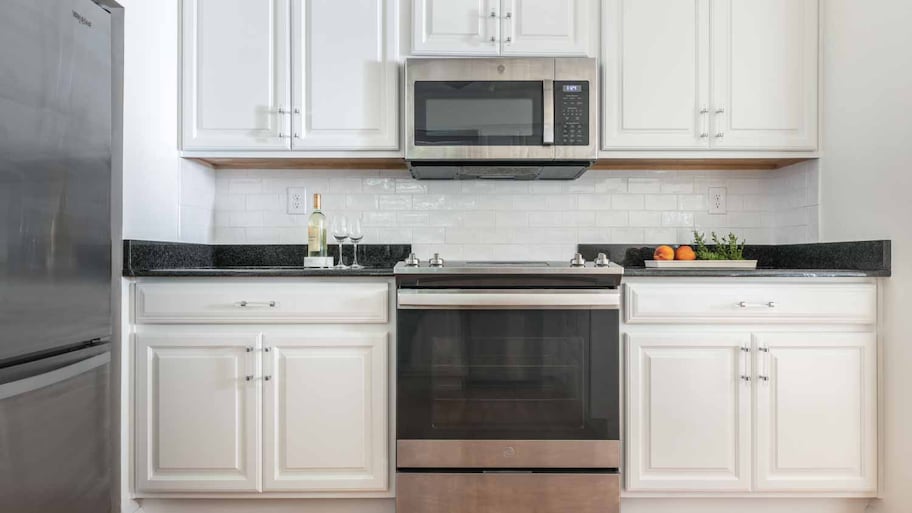
The price tag for a kitchen remodel might surprise you, but you should also know the added value of completing this home remodeling project.
Return on Investment
Kitchen remodels are an ROI-heavy project, with approximately 70% to 80%return on investment when you sell your home. There’s also the potential that you can sell your home faster with an appealing kitchen. Next to bathrooms, this is one of the highest ROIs for a home remodeling project.
Ask Angi: Which Home Projects Have High ROI?
Safety
Sometimes a remodel is necessary for a kitchen in an older home to bring it up to code or improve the safety of your home. For example, an older kitchen might not have circuit interrupter (GFCI) outlets. After all, kitchens are where you cook large meals using electricity—or open flames if you’re using gas—and power dishwashers to clean dishes. Fire and water damage are serious matters, and your and your family’s safety should come first.
Functionality
A kitchen might look great on the surface, but once you start cooking in one and trying to prep your daily meals, you’ll begin to notice how much longer everything takes when a kitchen setup is less than ideal. For passionate home cooks, improving the functionality—like increasing storage space, improving workflows, and upgrading appliances—of the space goes a long way.
Accessibility vs. Universal Kitchen Designs
A remodel can make your kitchen easier to navigate for people with disabilities, children, older adults, and any houseguests you plan to host. According to the National Association of Home Builders, universal design focuses on constructing spaces that are easier to use by all people. For example, an aging-in-place design may call for kitchen cabinet hardware that requires minimal effort to open, regardless of a person’s age or ability.
Energy Savings
Energy-efficient appliances can save you money in the long run, and they’re a more environmentally responsible option. Modern refrigerators use less energy, and newer dishwashers function on less water. You might find that some of these appliances pay for themselves over time. For example, you could save around $230 for the duration of the appliance by upgrading to an energy-efficient refrigerator, according to Energy Star.
Modern Aesthetic
For many, walking into the kitchen every day to prepare breakfast, make a snack, or spend time with friends and family becomes more enjoyable when the space looks more appealing and modern. Working with a designer or contractor to reimagine your kitchen can bring it up to date and align it better to your vision for your home.
How to Budget for Your Kitchen Remodel
With the average cost of a kitchen remodel around $26,945, you can set your budget higher or lower based on your needs. If you plan to keep the existing layout of your kitchen, you may be able to work with a smaller budget; however, if you’re demolishing and rebuilding a kitchen, you’ll want to set your budget higher.
Once you’ve set a budget, be sure to add some cushion for surprises—like an unexpected leak that needs repairing or old plumbing that needs replacing.
How to Save When Remodeling a Kitchen
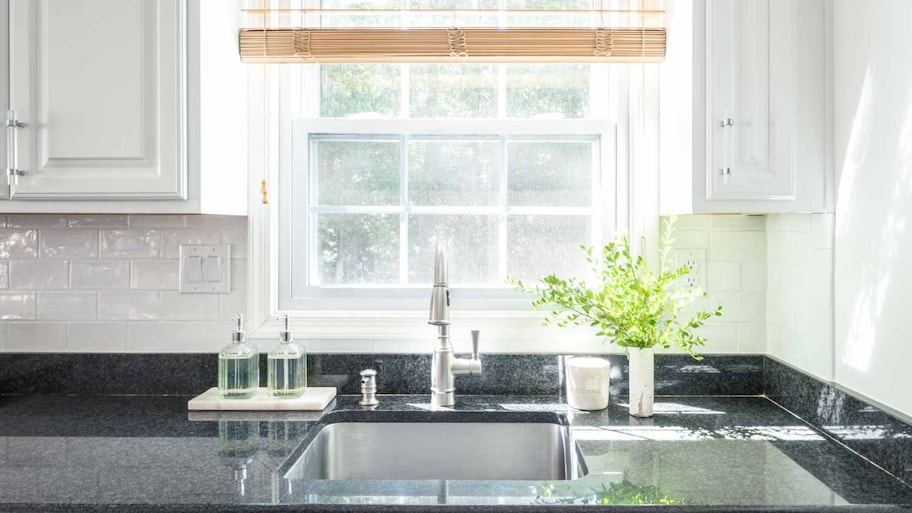
The trick to saving on kitchen remodels is knowing where to compromise and when you can save by doing a project yourself. Determine your budget before making any big decisions or commitments, then stick to it.
Don’t Scrap Your Cabinets: Cabinets are the most expensive component of a kitchen remodel, so keeping your existing cabinets will go a long. You can repaint or reface them with new doors and change out the hardware.
Keep Your Kitchen Footprint : Changing your kitchen’s footprint comes with expensive electrical and plumbing work. Instead, focus on a kitchen makeover that transforms your space without driving up costs.
Shop Around: Instead of a brand-new refrigerator, conider a floor model or a slightly damaged unit at a discount. Or, if you need to buy multiple of a certain item, get a discount by buying a bundle.
Use High-End and Low-End Products Where It Counts: Consider installing reused or refurbished cabinetry, and then attaching high-quality cabinet hardware to add some polish. Or buy a porcelain tile that looks like natural stone for an affordable backsplash option.
Vet Your Contractor : Before hiring a contractor, check their licenses and qualifications, and ask about previous work. Contact at least three pros for a quote and ask questions.
DIY vs. Hiring a Contractor to Remodel Your Kitchen
Hear it from a homeowner:
"Having someone with extensive work experience and knowledge in the area helped us tremendously [on] our first big remodel project. Our pro walked us through the process, provided detailed documentation on what to expect, how to prepare for the remodel, and patiently answered our (endless) questions before the remodel began."
— Edith K., Tigard, OR
Considering the range of updates involved in a kitchen remodel, you might find some projects you can do yourself, while for others, you’ll need to hire a pro. Opting to DIY some kitchen remodeling projects can offset some of the labor cost, which is often between $3,000 and $6,000, or 25% of the total kitchen remodel budget. Projects like installing a backsplash, replacing a garbage disposal, and painting walls might be tasks you can handle.
Since cabinets are the biggest cost in a kitchen remodeling project, you can cut costs by refinishing your existing cabinetry. If you’re an advanced-level DIYer, you may be able to install flooring, countertops, and cabinets.
On the other hand, hazardous or heavy-duty projects—like moving a heavy, natural stone countertop or rewiring a gas line—are better left to the pros. You should always leave potentially dangerous DIY projects involving plumbing and electrical work to licensed pros. Kitchen renovation pros in your area have the right tools, skills, and knowledge to get the job done right. Most kitchen remodels can be completed with a bit of DIY and some help from pros.
Common Kitchen DIY Projects
Depending on your comfort level, there may be some tasks you can take on without a pro. Some DIY-friendly kitchen projects include installing under-cabinet lighting with LED strips and upgrading your kitchen faucet. Other DIY projects to help lower the project cost include:
Painting your kitchen cabinets to match the new look
Removing wallpaper to refresh or paint
Purchasing and replacing kitchen cabinet hardware
Organizing your kitchen ahead of time to avoid unnecessary clutter
Adding contact paper to your countertops for a new, functional look
Painting countertops to revitalize your kitchen aesthetic
Installing cabinet door glass to allow your dinerware to shine bright
Installing kitchen backsplash to transform your space
Safely removing countertops to prepare for new ones
Kitchen Remodel Project Pitfalls to Avoid
Depending on the size of the project, a kitchen remodel can take up to four months or longer. Because it’s such a large undertaking, here are some common mistakes you can avoid to ensure your remodel ends on time and on budget.
Underestimating Your Budget
With supply chain and macroeconomic impacts, the home remodeling industry is more expensive than it was five or more years ago. It’s important to come prepared with a budget in mind, but also understand where you can have flexibility. If the top-of-the-line induction stove is a must-have, consider saving on a less expensive backsplash tile. If you’re prepared for increases in budget, you can quickly adjust with the guidance of your pro.
Going for the Lowest Bid
As the saying always goes: you get what you pay for. If a proposal seems too good to be true, it probably is. Be sure to get multiple bids from different contractors, and go over each of them in detail to understand what you’re getting.
Not Researching in Advance
Before picking up the phone and scheduling on-site visits, research what your larger vision is for your kitchen. Live out your Pinterest dreams and start collecting your favorite kitchen design trends, but also start to get realistic about what can fit into your budget and what can’t. It also helps to start brushing up on common remodeling terms, so when you’re meeting with your pro you’re speaking the same language.
Neglecting the Infrastructure
Electrical, plumbing, ventilation—these are important things that aren’t usually in the Pinterest vision board. If you’re changing the layout of your kitchen, these will become an even greater focus in your discussion.
Materials Arriving Late
Most heavy-duty materials, like a new marble slab or cabinetry, will be ordered and shipped on-site by the pro. But many remodelers ask homeowners to purchase smaller items like the following:
Tile for floors and backsplash
Finishes like handles and knobs for cabinetry
New appliances
This means you will also be responsible for the on-time arrival of those materials. It’s recommended to purchase all materials upfront at the very start of the project. It’s better to have items sitting at the jobsite ready to go over delaying the project days (or weeks) waiting for materials to arrive.
Not Planning Out How to Live During the Remodel
As mentioned before, kitchen remodels can last months. For a portion of that time, it means your kitchen could be completely out of commission. Ask your pro for a general schedule of when appliances won’t be installed and then work out how meals will be handled. You may want to consider a temporary kitchen in your house with a small mini fridge, stove top, and a few utensils in order to offset your takeout budget.
How Angi Gets Its Cost Data
Home is the most important place on earth, which is why Angi has helped more than 150 million homeowners transform their houses into homes they adore. To help homeowners with their next project, Angi provides readers with the most accurate cost data and upholds strict editorial standards. We’ve surveyed over 10,000 real Angi customers about their project costs to develop the pricing data you see, so you can make the best decisions for you and your home. We pair this data with research from reputable sources, including the U.S. Bureau of Labor Statistics, academic journals, market studies, and interviews with industry experts—all to ensure our prices reflect real-world projects.
Want to help us improve our cost data? Send us a recent project quote to [email protected]. Quotes and personal information will not be shared publicly.
Frequently Asked Questions
To decide on the extent of your kitchen remodel, start by taking inventory of your current kitchen and making a list of needs and wants. Then plug those items into your ideal budget and plan accordingly. If your budget allows you to hire a kitchen remodeler or kitchen refacing pro, you can outsource the project to a professional.
New cabinets typically cost the most in a kitchen remodel, which can eat up to 40% or more of the whole kitchen remodel budget. You can save by keeping your existing cabinets and giving them a makeover. The next largest cost is appliances because each new item can cost $500 or more. That may not be a big deal if you’re only replacing one appliance, but the combined price of many new appliances can significantly increase what you pay for a kitchen remodel.
Both minor and major kitchen remodels can increase your home’s value, with a predicted ROI of roughly 72%. That means you’ll likely win back most of your kitchen upgrade costs when it finally comes time to put your home on the market.
First, start with any planned structural changes. That includes demolition and installing new gas lines, piping, or lighting. From there, complete any projects that require a lot of construction to install. Paint your walls while the space is mostly empty, install the cabinets before the countertops to ensure the former doesn’t get damaged, and save all cosmetic changes (like installing new light fixtures or hardware) for the very last moment.
Kitchen remodels take six to 10 weeks on average, but this can vary a lot depending on contractors’ schedules and the availability of materials. You’ll also want to factor in about four weeks of planning time ahead of construction to ensure the project runs smoothly and turns out as planned. Including the planning stages, demolition, installations, and cleanup, the full remodel timeline can be up to four months.


